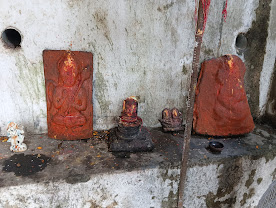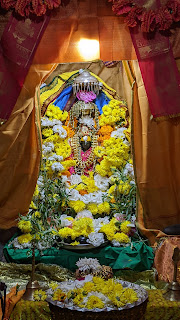Day - 5 (09/11/2024)
Our fourth day's itinerary: At Badari Kshetra, trek to Charan Paaduka, Mana Village (visited the previous day itself), Joshimath Shankaracharya Math and the night halt at Joshimath.
A recap of the fourth day's places of visit: Badari Kshetra, trek to Charan Paaduka, Hanuman Chatti, Pandukeshwar (Yogadhyan Badari), Vishnu Prayag, Joshimath Shankaracharya Math, Bhavishya Kedar and the night halt at Joshimath.
Plans for the fifth & sixth days: Gopeswar, Vaitarni, Tunganath, Anirudh Temple, Vishwanath Mandir, Maa Kali, Maa Tripura Sundari Lalita Mayi Mandir, Narayan Koti, Mundkatiya, Kalimath, Triyugnarayana, Agastymuni, Rudraprayag.
Join us, for a virtual tour of our Day 5 activities.
This morning, as was our routine, we started off early, to Vrudha Badari (the fourth of the five Badaris). Vrudha Badari is located at Animath in Chamoli district of Uttarakhand. The Vrudha Badari temple dates back to the time when India was ruled by the Gupta Dynasty. The Vrudha Badari is one of the “Sapta (Seven) Badaris” temples in the Badarikshetra (though only 5 Badaris are prominent. The other two Badaris are Arda Badari - that can be reached only by trekking and Narasingh Badari - The Narasimha Temple at Joshmath).
The legend of Vrudha Badari says that when the great sage Narada decided to perform penance at this place to please Lord Vishnu, the pleased Lord appeared before Narada disguised as an old man and answered his prayers. It is said that the Lord preached the knowledge of Anima Siddi to the Sage. The idol's face here is that of the elderly Lord, who appeared in front of the sage and hence called Vrudha Badari. The best way to visit the temple (without climbing up) is to get off the vehicle at the entrance of the temple stairways and get the vehicle to come over to the exit (around 2 km on motorable road) down the other way, where you can climb down to get on to the vehicle and conserve your energy for other places where climbing up is imminent.















Our next stop, Gopeshwar Mahadev or Gopinath Temple, which is an ancient Hindu temple dedicated to Shiva in Gopeshwar, Chamoli District, Uttarakhand, India. It is situated in Gopeshwar village now part of Gopeshwar town. The temple stands out in its architectural proficiency; it is topped by a magnificent dome and the 30 sq ft (2.8 m2) sanctum sanctorum, which is accessible by 24 doors.
The remains of broken idols found around the temple testify to the existence of several more temples in ancient times. There is a trident, in the courtyard of the temple, about 5 m high, made of eight different metals (Ashta Daatu), which dates back to the 12th century. It boasts the inscriptions attributed to Ashokchalla, the king of Nepal who reigned in the 13th century. Four short inscriptions written in Devanagari, which date back to a later period, are yet to be deciphered, barring one. The legend is that the trident got fixed in this spot when Lord Shiva threw it at Lord Kama to kill him. The metal of the trident is not weathered by the elements and this is a wonder. The legend goes that the trident belonged to Shiva who threw it at Kamdeva (The God of Love) to kill him and it got fixed in this spot. It is believed that while brute force can’t move this Trident, the slightest touch by a true devotee can cause a tremor in it. The metal of the trident does not appear to have become weathered by the elements over the century[1].


Plan vs. Actual:
Gopeshwar and out-of-itinerary places Kalpeshwar and Dhyan Badari were covered. Due to the paucity of time, we couldn’t visit other places like Anusuya Temple, Agastya Muni Ashram, Chandika Devi Temple, Vaitarani Dhara, Tunganath, etc. While Anirudh Temple, Vishwanath Mandir, Maa Kali, Maa Tripura Sundari Lalita Mayi Mandir, Narayan Koti, Mundkatiya, Kalimath, Triyugnarayana, etc., were deferred to day 6.
----------------------------------------
Camp Coordinates: Hotel Shri Hari & Restaurant, Sirshi, Phata, Rudraprayag, NH-109, Kedarnath Rd, Badalpur, Uttarakhand 246471 Phone: 094111 83894
https://maps.app.goo.gl/FF9u8K1D6YgFG2jQA
----------------------------------------
Continued .... in Part 6
[1] From the website https://en.wikipedia.org/wiki/Gopinath_Mandir



.jpeg)



.jpeg)

.jpg)
1 comment:
Excellent account of the visit ti the abode of our Gods
Post a Comment